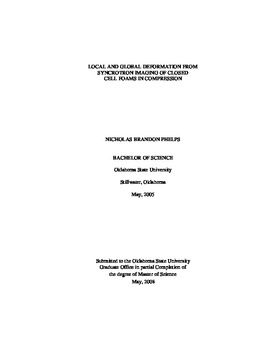| dc.contributor.advisor | Hanan, Jay C. | |
| dc.contributor.author | Phelps, Nicholas Brandon | |
| dc.date.accessioned | 2014-04-17T19:53:36Z | |
| dc.date.available | 2014-04-17T19:53:36Z | |
| dc.date.issued | 2008-05-01 | |
| dc.identifier.uri | https://hdl.handle.net/11244/10026 | |
| dc.description.abstract | Foams are cellular structures, which are made from an increasingly wide variety of materials. Current foam processing methods randomly places cells, making a complex microstructure. These microstructures provide foams with the mechanical properties needed for excellent impact energy absorption as evidenced by their response under compressive stress. There are three primary regions of the stress-strain curve during compression: linear elastic, plateau, and densification. The combination of these three regions makes foams mechanically suitable for energy absorption. Recently, new metal foams made of Pd43Ni10Cu27P20 bulk metallic glass (BMG) have been successfully produced. Their mechanical properties were explored and an X-ray analysis procedure was developed. This procedure was also tested on a polymer (polymethacrylimide) foam with similar relative density to the metal foam. The polymer foam was tested in compression comparing two commercially available materials testers and a custom built Diffraction-Tomography Materials Tester (D-tmT) recently designed at OSU. Radiographs and tomographs were taken of the polymer sample while it was compressed using the D-tmT at the Advanced Photon Source. Control and sensing software was written in LabVIEW to automate tension, compression, and fatigue tests on the D-tmT. Similarly synchrotron radiation was used to monitor the microstructure of the BMG foam in compression. Dynamic compression was also performed for the first time on BMG foam using a Split Hopkinson Pressure Bar (SHPB). Image processing was used on the tomographs from both the polymer and BMG foams for qualitative comparison to computational results. Using advanced X-ray analysis, the mechanical properties of foams are understood through a connection with global stress and strain to local microstructure deformation. | |
| dc.format | application/pdf | |
| dc.language | en_US | |
| dc.publisher | Oklahoma State University | |
| dc.rights | Copyright is held by the author who has granted the Oklahoma State University Library the non-exclusive right to share this material in its institutional repository. Contact Digital Library Services at lib-dls@okstate.edu or 405-744-9161 for the permission policy on the use, reproduction or distribution of this material. | |
| dc.title | Local and Global Deformation From Syncrotron Imaging of Closed Cell Foams in Compression | |
| dc.type | text | |
| dc.contributor.committeeMember | Smay, Jim E | |
| dc.contributor.committeeMember | Lu, Hongbing | |
| osu.filename | Phelps_okstate_0664M_2605.pdf | |
| osu.college | Engineering, Architecture, and Technology | |
| osu.accesstype | Open Access | |
| dc.description.department | Mechanical & Aerospace Engineering | |
| dc.type.genre | Thesis | |
